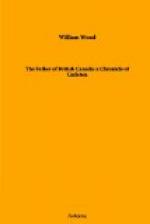Meanwhile Carleton and Washington had exchanged the usual compliments on the conclusion of peace and had met each other on the 6th of May at Tappan, where they discussed the exchange of prisoners. By the terms of the treaty the British were to evacuate New York, their last foothold in the new republic, with all practicable dispatch; so, as summer changed into autumn, the Congress became more and more impatient to see the last of them. But Carleton would not go without the Loyalists, whose many tributary streams of misery were still flowing into New York. In September, when the treaty of peace was ratified in Europe, the Congress asked Carleton point-blank to name the date of his own departure. But he replied that this was impossible and that the more the Loyalists were persecuted the longer he would be obliged to stay. The correspondence between him and the Congress teems with complaints and explanations. The Americans were very anxious lest the Loyalists should take away any goods and chattels not their own, particularly slaves. Carleton was disposed to consider slaves as human beings, though slavery was still the law in the British oversea dominions, and so the Americans felt uneasy lest he might discriminate between their slaves and other chattels. Reams of the Carleton papers are covered with descriptive lists of claimed and counter-claimed niggers—Julius Caesars, Jupiters, Venuses, Dianas, and so on, who were either ‘stout wenches’ and ‘likely fellows’ or ‘incurably lazy’ and ‘old worn-outs.’
Perhaps, when a slave wished to remain British, and his case was nicely balanced between the claimants and the counter-claimants, Carleton was a little inclined to give him the benefit of the doubt. But with other forms of disputed property he was too severe to please all Loyalists. A typical case of restitution in Canada will show how differently the two governments viewed the rights of private property. Mercier and Halsted, two Quebec rebels, owned a wharf and the frame of a warehouse in 1775. It was Arnold’s intercepted letter to Mercier that gave Carleton’s lieutenant, Cramahe, the first warning of danger from the south. Halsted was Major Caldwell’s miller at the time and took advantage of his position to give his employer’s flour to Arnold’s army, in which he served as commissary throughout the siege. Just after the peace of 1783 Mercier and Halsted laid claim to their former property, which they had abandoned for eight years and on which the government had meanwhile built a provision store, making use of the original frame. The case was complicated by many details too long for notice here. But the British government finally gave the two rebels the original property, plus thirteen years’ rent, less the cost of government works erected in the meantime. All the documents are still in Quebec.




